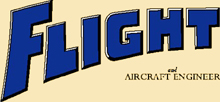Toss bombs for R.A.F. The American Minneapolis-Honeywell Regulator Company has been granted an export licence to supply an unspecified quantity of Low Altitude Bombing System equipment to the R.A.F. under a £267,850 contract. The L.A.B.S. bomb-sight is small enough to fit into single-seat fighters and is already in use by the U.S.A.F. and U.S. Navy. It is used for aiming small tactical bombs, which are lobbed or tossed from a roll-off-the-top so that after its low-level approach, the aircraft can clear the target area without risk from the subsequent explosion. A L.A.B.S.-type sight is also being developed in Britain. The Canberra and such aircraft as the N.113 and N.A.39 are the most likely candidates for L.A.B.S. First Missile Regiment The first guided-missile regiment in Britain is now being formed at Crookham, Hants, to handle American Corporal ground-to-ground missiles, some of which have already been delivered. The unit is to be known as 47 Guided Missile Regiment (Field), R.A., and it will comprise about 530 men, some of whom have been trained in America and will act as instructors. American Corporal battalions normally fire two live rounds during initial training. Aden Action On Monday last the village of Danaba in the West Aden Protectorate was attacked and destroyed by R.A.F. Shackletons and Venoms, using bombs and rockets, in an operation lasting over five hours. It was carried out as a reprisal for the ambush of a British patrol near Dhala last week, when two Cameron Highlanders were killed, by tribesmen from Danaba. There were no people or animals in the village at the time of the raid. Leaflets had been dropped for four days previously, warning that it would take place unless the ringleaders surrendered. Britannias by Road Among the chief sub-contractors for the Bristol Britannias are Blackburn (Dumbarton), Ltd., the well-known Scottish subsidiary of Blackburn and General Aircraft, Ltd. They are making complete Britannia centre-fuselages, fuselage panels, stern-frames, dorsal fins, wing-tips, and other structural components. An interesting feature of this work is that much of the output goes to the Britannia assembly-line at Belfast, and this involves a fairly complicated journey for the components. |
Source: Flight International






















